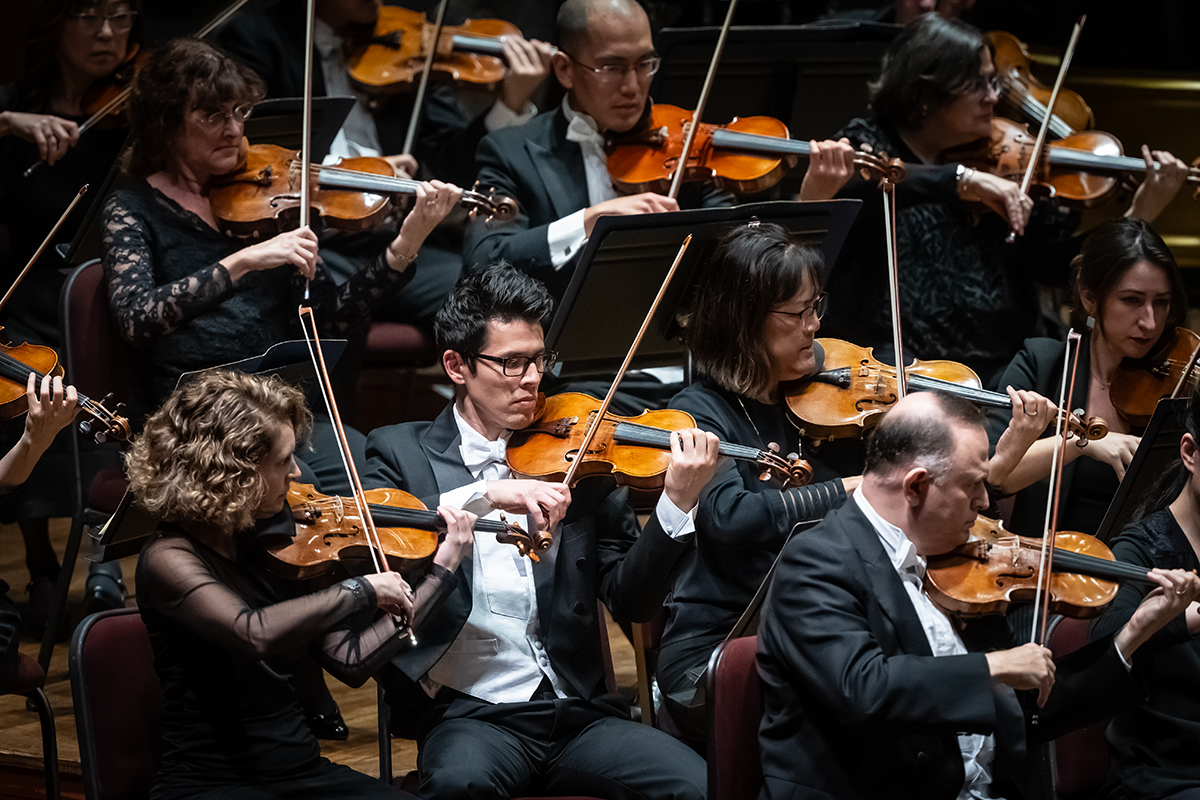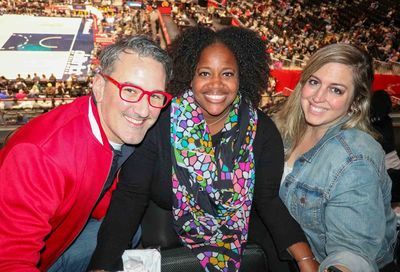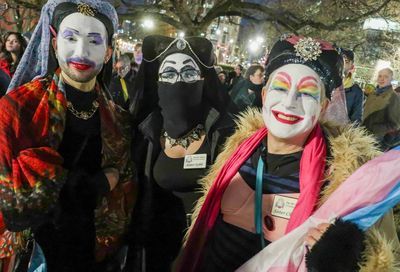Ringing True: WNO’s Ring Cycle (review)
The first two operas in WNO's Ring Cycle are powerfully sung, brilliantly staged, and stunningly executed

With Washington’s first-ever complete Ring of the Nibelung (![]()
![]()
![]()
![]()
![]() ), director Francesca Zambello achieves an extraordinary milestone — not just in staging the four operas consecutively, but in bringing her own voice and vision to Wagner’s saga of conflicted Norse gods and their troubled entanglements with giants, dragons, earth spirits and a few bewildered mortals. Her Ring (a co-production with San Francisco Opera) has taken more than a decade to develop, surviving not just the usual financing woes of the arts, but a full-blown recession. It may not be perfect (and it has been modulated over its years in development), but it arrives clear, strong and with more imaginative power than ever. It’s a testament to Zambello’s determination to grow the art form.
), director Francesca Zambello achieves an extraordinary milestone — not just in staging the four operas consecutively, but in bringing her own voice and vision to Wagner’s saga of conflicted Norse gods and their troubled entanglements with giants, dragons, earth spirits and a few bewildered mortals. Her Ring (a co-production with San Francisco Opera) has taken more than a decade to develop, surviving not just the usual financing woes of the arts, but a full-blown recession. It may not be perfect (and it has been modulated over its years in development), but it arrives clear, strong and with more imaginative power than ever. It’s a testament to Zambello’s determination to grow the art form.
Directors are not shy in giving their Rings an update. They come in many forms, from the minimalist to the sci fi to the utterly traditional, with breastplates and medieval garb. Zambello’s is known as the American Ring because she, in large part, interprets the story through this country’s lens, historically and culturally referencing iconic times, places and vistas.
But to see this as another in the trend of flag-waving in the arts would be shortsighted. Wagner is far too dark and Zambello far too complex. Truth be told, there is something quite wonderfully un-American in the look and feel of these productions (all of which have been staged individually by the WNO over past seasons). In particular, set designer Michael Yeargan may invoke American epochs (a panhandling 49er, a vintage boardroom), places (urban underpasses and scrubland) or moods (the austere palette of Frederic Church, the hyper-real vibrancy of Maxfield Parrish), but his sensibility is also European. There is very much the suggestion of an eons-old Continental grandeur in Wotan’s mountaintop home, a fiery Lord of the Rings-esque underworld in the Nibelung’s caves, and a distinctly post-modern vision in the urban scenes. Add the number of sleek leather dusters that at a glance look awfully Germanic and the productions evoke far more of the Old World than the New.
However one views them, these evocations provide an array of interesting moods and flavors. But Zambello’s innovation does not stop with the mood and imagery. She also reveals a deep interest in Wagner’s women. There is powerful commentary here on the vulnerability of women in the face of male brutality and power. It appears in the way Alberich tries to crudely force a river maiden into his crotch in the opening scene of The Rhinegold, the way in which Hunding handles the submissive Sieglinde in The Valkyrie, her arms covered in bruises, and the anger of Fricka as a woman roundly humiliated — and now defined — by husband Wotan’s unfaithfulness.”

By the time the confident and much loved Brunnhilde arrives in father Wotan’s boardroom in The Valkyrie, she is a revelation in comparison to the powerless women who have come before her. When she gives her signature battle cry, she is a symbol of power and self-determination. As such, it delivers a far greater pathos to her later fall from grace, at the hands, yet again, of a man. When Wotan condemns her to be the bride of a mortal man, left to sew before his fire in humiliation, he is taking her power, her independence and her equality. Zambello gives compelling emphasis to these aspects in her contrasts. It is also quite fascinating to realize that Wagner himself spoke to them when he penned Die Walkure in 1856.
Thus Zambello brings these intriguing features to her Ring, but she also embraces Wagner’s more primal and ominous themes: the poor and weak may be ruled by the powerful, but life is capricious, power is fragile, and death is coming not just to us all, but perhaps even the universe.
She captures much of the enormity in the first opera of the cycle, The Rhinegold, through the use of the extraordinary projections of Jan Hartley and S. Katy Tucker. There is a long tradition in film of contrasting music with imagery, and its incorporation into opera has been a revelation. Back in 2003, for example, while in temporary digs at DAR Constitution Hall, the WNO’s staging of The Valkyrie by necessity relied on projections. But those long looping clips of depthless, angry waves and desolate brackish winter waters were deeply poignant and evocative.
Such power returns here. As the overture begins, an amorphous, subtle cloud begins to roil and change with Wagner’s ominous score, evolving into a phenomenal array of color and movement evoking everything from the farthest reaches of the universe to a bloodstream, to quarks and atoms, and to oblivion. It is profoundly moving.
It also sets an entire frame of mind for what is to come. When the projections return later they serve as evocative segues and interludes as the story moves between the mountain top retreat of the gods and the underground world of the Nibelung.
The beautiful imagery, Yeargan’s evocative sets and Zambello’s clear storytelling make for a powerful vehicle. They also overcome aspects that, at times, works less well in the quest to keep Rhinegold accessible: a few creative translations of the libretto that grate (a shorthand to “slimy sluts”); Alberich’s rather crude handling of the river maidens; his later transformation into a silly toad prop; and some less successful attempts to bring dramatic realism to some of the more protracted scenes. Case in point is the long negotiation in which Wotan tries to get out of his promise to give Fricka’s sister Freia to the giants Fasolt and Fafner in payment for building Valhalla. Melody Moore tries to convince, but her Freia is caught in an endless unconvincing do-loop between panic and relief as the negotiations vacillate.
But these moments aside, the drama and the key roles here are powerfully intact. As Alberich, the underground-dwelling Nibelung who steals the gold from the river maidens and creates the ring that will bring destruction to all who own it, Gordon Hawkins is menacing and memorable, especially once he has found power. As Wotan, the god who must obtain the gold from Alberich if he is to free Freia, Alan Held is utterly in his element, mixing godlike certainty with a more recognizable fallibility. A commanding presence, he sings with handsomely expressive tone. Elizabeth Bishop’s Fricka is convincingly acted and her mezzo-soprano attractively full-bodied (though richer and more glorious in The Valkyrie). As Loge, Wotan’s frenemy who helps secure him the gold, William Burden is convincing in his duplicitous cheeriness and sings with a pleasingly bright tenor. As the three river maidens, Renee Tatum, Jacqueline Echols and Catherine Martin offer a blend of exquisite, lush, and otherworldly sound, even if their cavorting around Alberich is rather aimless and awkward. Another standout is Julian Close as Fasolt, who sings with a quietly thundery bass. Finally, Lindsay Ammann makes a beautifully choreographed entrance as Erda and delivers her desolate warning to Wotan with a hauntingly resonant contralto.
As we leave The Rhinegold, the gods are cheerful and oblivious, climbing an impressively immense gangway to Valhalla. But they leave in their wake the river maidens, begging for their help and setting the stage for The Valkyrie, in which their troubles compound and Wotan becomes his own worst enemy.
And this Ring’s Valkyrie is very much the production seen at the WNO in 2007, losing none of its dramatic intensity. That said, there is no doubt that the opening scene in which the mortal Siegmund (albeit a mortal fathered by Wotan) stumbles across his long-lost sister Sieglinde and her odious husband Hunding, has its challenges. As beautiful as the music may be, it is, dramatically speaking, long-winded. It’s a lot of posturing for Hunding, a lot of brooding for Siegmund and a great deal of cowering from Sieglinde. It certainly helps that Zambello brings a certain relevance in this Sieglinde and Meagan Miller’s portrayal of the abused woman is compelling. It is so strong, in fact, it even helps to explain her ability to accept her brother as her lover. Her sense of self has already been destroyed by the brutal Hunding, what do her choices matter now?
But Miller doesn’t just breathe life into Sieglinde and her suffering, she sings her into a soaring, transcendent sadness — first as she goes on the run with Siegmund and then, after his death, when she finds a reason to live in the promise of her unborn child.
In the role of Siegmund, another in the list of Wagner’s men who are not easy to love, Christopher Ventris, singing with energy if not much nuance, brings a tenderness towards Sieglinde that goes at least some way to mitigate the creepiness of his passion for her and his if-I-can’t-have-her-nobody-can moment. As Hunding, Raymond Aceto delivers a clearly defined villain and sings with a pleasingly growly bass.
But for most fans, even those who have only a passing familiarity with the Ring, the highlights of The Valkyrie come with acts two and three. They bring a return to the realm of the gods and the arrival of Brunnhilde, her sisters, and their incredibly rousing battle song. It is music to be heard live and conductor Philippe Auguin, bringing a tremendous performance from the WNO orchestra throughout, does not disappoint. It is also one of Zambello’s most inventive turns, flying her Valkyries down from the heavens in the form of vintage paratroopers, singing in a fabulous array of richly wondrous power-voices. Returning also from 2007 are the photographs they carry as symbols of the fallen warriors they will bring to Valhalla. As before, they are the hauntingly handsome faces of young men lost in the wars in Afghanistan and Iraq.
It is not just the excitement of the Valkyries that makes these acts so absorbing, this part of the story also brings some of the Ring’s most emotionally potent moments. As we return to the gods, Fricka is turning the screws on Wotan, forcing him to renounce Siegmund, even though Wotan sees him as the man who can save the gods from the doom predicted by Erda in The Rhinegold. Elizabeth Bishop not only captures Fricka’s scorn, she has believable chemistry with Held’s Wotan. When Brunnhilde arrives, happy and confident as the apple of her father’s eye, Fricka’s disdain and the full picture of the family dynamic is revealed. It creates a meaningful context for the later disastrous falling out between Wotan and Brunnhilde, when she defies his wishes and tries to save Siegmund. The love is deep, but the dysfunction is deeper in this privileged family.
The capturing of their relationship is crucial if we are to feel the tragedy of Wotan’s decree that Brunnhilde be made mortal and left for the first mortal man who wakes her. It’s a tall order at the best of times, but even more so under the circumstances of this Ring’s opening: an injury sidelining Catherine Foster. Christine Goerke stepped in at the last minute and does a superb job in giving her young woman a convincingly youthful gusto and irreverence, as well as a glimpse of fear and heartbreak, despite her strength. Goerke sings her with golden tenacity and expressive power — and a most gratifying “hojotoho.” And there is very much the feeling of father-daughter chemistry with Held’s Wotan. Held exudes palpable suffering in his decision and when he tears off his coat to cover his sleeping daughter and issues his protective might over her vulnerable body, the moment is nothing less than stunning.
Up next are Siegfried and finally Twilight of the Gods (or Gotterdammerung). There is no doubt: to see these operas together as intended is a gift. For those who can clear their mental and physical decks — and that is no small feat as these are long, really long, operas — Zambello’s Ring is an aural, visual and spiritual event: an immersion in a dark and extraordinarily beautiful world like no other.
The Ring Cycle runs to May 22 — The Rhinegold closes May 17, The Valkyrie May 18, Siegfried May 20, and Twilight of the Gods May 22 — at the Kennedy Center Opera House, 2700 F Street, NW Washington, DC. Tickets are $75 to $525. Call 202-467-4600 or visit kennedy-center.org.
Support Metro Weekly’s Journalism
These are challenging times for news organizations. And yet it’s crucial we stay active and provide vital resources and information to both our local readers and the world. So won’t you please take a moment and consider supporting Metro Weekly with a membership? For as little as $5 a month, you can help ensure Metro Weekly magazine and MetroWeekly.com remain free, viable resources as we provide the best, most diverse, culturally-resonant LGBTQ coverage in both the D.C. region and around the world. Memberships come with exclusive perks and discounts, your own personal digital delivery of each week’s magazine (and an archive), access to our Member's Lounge when it launches this fall, and exclusive members-only items like Metro Weekly Membership Mugs and Tote Bags! Check out all our membership levels here and please join us today!






















You must be logged in to post a comment.